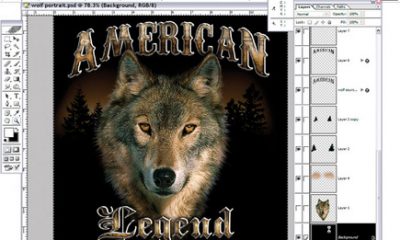Digital Printing
Published
18 years agoon
What do the Earth's surface and the installed base of wide-format inkjet printers have in common? I would be shocked to hear that anyone has even slightly pondered this question, so let me give you the answer. Approximately 71% of both are filled with water. Yes, it's true. And just how are they different? The position of one is shrinking and the other is rising. I'm sure that it will come as little surprise as to which is doing what.
Where did I come up with such trivia? Well, I often find myself in random places staring blankly at the world around me in order to find ideas for my column. This time, I spent a rainy Saturday afternoon in the café of a bookstore, enjoying a 20-ounce latté that made the price of a gallon of gasoline almost seem like a bargain. During my visit, I headed over to the American classics and ended up leafing through Mark Twain's works. Interestingly, some of Twain's ideas apply to this month's column, so I've enlisted the help of a few notable quotes of his in discussing the topic at hand: the position of the wide-format aqueous inkjet printer.
"Get your facts first, and then you can distort them as much as you please."
I really appreciate this quote, though it hits a little close to home. Some believe that analyzing statistics is fun. I'm one of those people, and I feel that doing so is necessary in order to really understand markets and opportunities—both established and emerging. But interpreting numbers, maintaining data, and relating these figures to the real world is often quite tricky. In a vacuum, making sense of the numbers would be easy. But the challenge is often taking data and creating analyses that answer the questions, "Why?" and "Does that take into account the whole market picture?"
Much has been said and published over the past two years about the imminent fall of aqueous inkjets at the hands of solvent and UV-curable inkjet technology for wide-format graphics. And to be fair, I have made my own assertions based on the results of Web Consulting's research. "Facts are stubborn, but statistics are more pliable," Twain said. I am starting to think he had something against numbers.
"The reports of my death have been greatly exaggerated."
I can only imagine Twain's amusement when he sent this message via telegraph to the US press upon reading his own obituary while in London. However, less amusing were the predictions made over the past ten years about the rapid demise of several markets and technologies. While some were accurate, many have yet to—and may never—be realized. The three that immediately come to mind are graphics screen printing, wide-format aqueous inkjet printing for graphics, and the market for cut vinyl. One false market explosion is the digital printing of textiles, but that's another story for another time. Since my thoughts on the US cut-vinyl market and the future challenges facing graphics screen printing have already been published in the pages of this magazine, I will focus on aqueous inkjets here.
With all of the attention placed on solvent and UV inkjet printing over recent years, one might think that the days of wide-format aqueous inkjet printing are numbered. But the bottom line is that aqueous inkjet technology is not extinct; nor is it quickly disappearing from the wide-format market. Is it losing share? Without a doubt. But to be fair, aqueous inkjet technology captured 89% of the active US installed base of wide-format inkjet printers in 2003, so there was only one direction that aqueous inkjet's position could realistically take. Nevertheless, aqueous inkjet still captured 71% of the US installed base of graphics printers two years later.
My statement that 71% of wide format inkjet printers are water-based machines could be open to challenge. While that finding is absolutely true when applied only to the US market for inkjet-printed graphics, is it still accurate when looking at the entire market for inkjet printers 24 in. wide and up? The answer is no. In fact, that statement would no longer hold water (sorry, I just had to). And I would venture to guess that most reading this article saw that 71% and thought only of graphics printers. But what about technical (CAD) printers? I realize that technical printing may not impact many businesses, but it should not always be omitted from facts and figures. Including those technical printers in an assessment of the marketplace puts the aqueous inkjet in very different place among all wide-format printers.
There is no question that the global growth of the digital-printing side of the wide-format-graphics industry has been significant. And the adoption of inkjet technology has been vast across many types of users. Historically, the sales of inkjet printers for wide-format technical applications has often been more than four times the sales volume of printers sold to produce conventional graphics. Today, the ratio of aqueous inkjets for graphics to technical printers on a worldwide sales basis is nearly one to one. And if you think that aqueous inkjet technology is no longer significant, I beg to differ. Including both the sales of wide-format printers for graphics and for technical applications, aqueous inkjet still captures more than 90% of global wide-format-printer sales.
"We are all alike, on the inside."
So you may feel that I am looking through rose-colored glasses to make my point about aqueous inkjets. And you might be correct, as I am only talking about the number of printers sold or in the installed base. I have not taken the volume of printing or the productivity of machines into account—factors that obviously vary from one imaging technology to another. But while it is true that non-aqueous-inkjet technologies are capturing a larger share of wide-format output, I feel that a place will continue to exist for aqueous technology for many years to come. Even though I can't see aqueous inkjet holding on to the lion's share of the entire market, I see no reason why aqueous inkjet can't continue to capture most of the volume for photographic enlargements, fine art, proofing, and other applications that require high-resolution or glossy output.
The real question, however, should be: "How do I continue to make money at this?" In taking an objective view of the printers on the market, there are probably hundreds of different models using a limited number of inkjet printheads. Many of these printers therefore make use of the same core technology as dozens of other printers on the market. So the key for both manufacturers and print shops alike is to successfully differentiate themselves and their products from the competition. Opportunities certainly exist in the marketplace, though they—and their related applications—are fragmenting and becoming more specialized as the market for wide-format printed graphics grows.
As a frequent speaker at industry trade shows and conferences, I need to make sure that I understand not only what the numbers mean, but also what's the whole story and why. In this ever-changing and complex market it is important to make critical and calculated decisions. Twain said, "It is wiser to find out than suppose." Using an aqueous inkjet printer for all of your graphics-printing needs may not be as popular a move as it once was, but the technology has its place and continues to serve admirably there.
About the author
Michael Flippin is the president of Web Consulting, Inc. The company was founded in Oxfordshire, UK, in 1993, and serves a global consultancy to the digital-printing, screen-printing and industrial-decoration industries. Web Consulting has offices in Boston, MA, Shanghai, China, and Oxfordshire, UK. You can learn more about the company at www.web-na.com.

Subscribe

Magazine
Get the most important news
and business ideas from Screenprinting Magazine.
Most Popular
-

 Case Studies2 months ago
Case Studies2 months agoHigh-Density Inks Help Specialty Printing Take Center Stage
-

 Art, Ad, or Alchemy2 months ago
Art, Ad, or Alchemy2 months agoF&I Printing Is Everywhere!
-

 Andy MacDougall2 months ago
Andy MacDougall2 months agoFunctional and Industrial Printing is EVERYWHERE!
-

 Columns3 weeks ago
Columns3 weeks ago8 Marketing Mistakes Not to Make When Promoting Your Screen Printing Services Online
-

 Editor's Note3 weeks ago
Editor's Note3 weeks agoLivin’ the High Life
-

 Marshall Atkinson3 weeks ago
Marshall Atkinson3 weeks agoHow to Create a Winning Culture in Your Screen-Printing Business
-

 Thomas Trimingham2 months ago
Thomas Trimingham2 months ago“Magic” Marketing for Screen Printing Shops
-

 News & Trends2 months ago
News & Trends2 months agoWhat Are ZALPHAS and How Can You Serve Them in Your Print Business?






